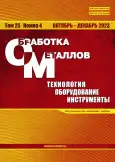Influence of the shape of the toroidal flank surface on the cutting wedge angles and mechanical stresses along the drill cutting edge
- Authors: Pivkin P.M.1, Ershov A.A.1, Mironov N.E.1, Nadykto A.B.1
-
Affiliations:
- Issue: Vol 25, No 4 (2023)
- Pages: 151-166
- Section: EQUIPMENT. INSTRUMENTS
- URL: https://journal-vniispk.ru/1994-6309/article/view/301467
- DOI: https://doi.org/10.17212/1994-6309-2023-25.4-151-166
- ID: 301467
Cite item
Abstract
Keywords
About the authors
P. M. Pivkin
Email: pmpivkin@gmail.com
Ph.D. (Engineering), Moscow State University of Technology "STANKIN", 3a Vadkovski Lane., Moscow, 127055, Russian Federation, pmpivkin@gmail.com
A. A. Ershov
Email: a.ershov@stankin.ru
Moscow State University of Technology "STANKIN", 3a Vadkovski Lane., Moscow, 127055, Russian Federation, a.ershov@stankin.ru
N. E. Mironov
Email: dzr1380im@gmail.com
Moscow State University of Technology "STANKIN", 3a Vadkovski Lane., Moscow, 127055, Russian Federation, dzr1380im@gmail.com
A. B. Nadykto
Email: a.nadykto@stankin.ru
D.Sc. (Physics and Mathematics), Professor, Moscow State University of Technology "STANKIN", 3a Vadkovski Lane., Moscow, 127055, Russian Federation, a.nadykto@stankin.ru
References
- Режущий инструмент / Д.В. Кожевников, В.А. Гречишников, С.В. Кирсанов, В.И. Кокарев, А.Г. Схиртладзе; под ред. С.В. Кирсанова. – 3-е изд. – М.: Машиностроение, 2007. – 526 с. – ISBN 978-5-217-03373-7.
- Семенченко И.И., Матюшин В.М., Сахаров Г.Н. Проектирование металлорежущих инструментов. – М.: Машгиз, 1963. – 952 с.
- An applied explicit mathematical model of conical drill point geometry without flank rubbing / T. Zeng, Z.C. Chen, Z. Liu, Z. Yi, S. Wang // The International Journal of Advanced Manufacturing Technology. – 2020. – Vol. 106 (9–10). – P. 3707–3720. – doi: 10.1007/s00170-019-04759-y.
- Патент № 2528593 Российская Федерация. Спиральное сверло с криволинейными режущими кромками: заявл. 17.12.2012: опубл. 20.09.2014 / Ю.Е. Петухов, А.А. Водовозов.
- Investigation of the effects of drill geometry on drilling performance and hole quality / M. Yavuz, H. Gökçe, I. Çiftçi, H. Gökçe, Ç. Yavas, U. Seker // The International Journal of Advanced Manufacturing Technology. – 2020. – Vol. 106 (9–10). – P. 4623–4633. – doi: 10.1007/s00170-019-04843-3.
- Abele E., Fujara M. Simulation-based twist drill design and geometry optimization // CIRP Annals. – 2010. – Vol. 59 (1). – P. 145–150. – doi: 10.1016/j.cirp.2010.03.063.
- Pirtini M., Lazoglu I. Forces and hole quality in drilling // International Journal of Machine Tools and Manufacture. – 2005. – Vol. 45 (11). – P. 1271–1281. – doi: 10.1016/j.ijmachtools.2005.01.004.
- Ren K., Ni J. Analyses of drill flute and cutting angles // The International Journal of Advanced Manufacturing Technology. – 1999. – Vol. 15 (8). – P. 546–553. – doi: 10.1007/s001700050100.
- A new method for the precise determination of rational geometric parameters of the helical groove and cutting part of high-performance tri-flute / P.M. Pivkin, V.A. Grechishnikov, A.A. Ershov, A.B. Nadykto // Proceedings of SPIE. – 2020. – Vol. 11540. – P. 1154014. – doi: 10.1117/12.2574392.
- Grigor'ev S.N. Volosova M.A. Complex surface hardening of oxide-carbide ceramic cutting tools // Russian Engineering Research. – 2005. – Vol. 25 (9). – P. 7–12.
- Geometry modifications of single-lip drills to improve cutting fluid flow / A. Baumann, E. Oezkaya, D. Biermann, P. Eberhard // The International Journal of Advanced Manufacturing Technology. – 2022. – Vol. 121 (3–4). – P. 1689–1695. – doi: 10.1007/s00170-022-09400-z.
- Grigor’;ev S.N., Myachenkov V.I., Kuzin V.V. Automated thermal-strength calculations of ceramic cutting plates // Russian Engineering Research. – 2011. – Vol. 31 (11). – P. 1060–1066. – doi: 10.3103/S1068798X11110086.
- Study on nano-cutting of brittle material by molecular dynamics using dynamic modeling / J. Wang, X. Zhang, F Fang, F. Xu, R. Chen, Z. Xue // Computational Materials Science. – 2020. – Vol. 183. – P. 109851. – doi: 10.1016/j.commatsci.2020.109851.
- A review of simulation and experiment research on cutting mechanism and cutting force in nanocutting process / D. Chen, S. Wu, Y. He, Y. Luo, X. Wang // The International Journal of Advanced Manufacturing Technology. – 2022. – Vol. 121 (3–4). – P. 1533–1574. – doi: 10.1007/s00170-022-09051-0.
- Finite element modelling and experimental validation of the graphite cutting process / D. Yang, F. Wei, W. Wang, Y. Zhang, L. Zeng // Processes. – 2023. – Vol. 11 (9). – P. 2546. – doi: 10.3390/pr11092546.
- Wang J., Fang F., Li L. Cutting of graphite at atomic and close-to-atomic scale using flexible enhanced molecular dynamics // Nanomanufacturing and Metrology. – 2022. – Vol. 5 (3). – P. 240–249. – doi: 10.1007/s41871-022-00128-8.
- Wang J., Fang F. Nanometric cutting mechanism of silicon carbide // CIRP Annals. – 2021. – Vol. 70 (1). – P. 29–32. – doi: 10.1016/j.cirp.2021.04.068.
- Effect of boron-doped diamond interlayer on cutting performance of diamond coated micro drills for graphite machining / X. Lei, L. Wang, B. Shen, F. Sun, Z. Zhang // Materials. – 2013. – Vol. 6 (8). – P. 3128–3138. – doi: 10.3390/ma6083128.
- Agapiou J.S., DeVries M.F. On the determination of thermal phenomena during drilling. Part I. Analytical models of twist drill temperature distributions / J.S. Agapiou, M.F. DeVries // International Journal of Machine Tools and Manufacture. – 1990. – Vol. 30 (2). – P. 203–215. – doi: 10.1016/0890-6955(90)90130-B.
- Thermal aspects in deep hole drilling of aluminium cast alloy using twist drills and MQL / D. Biermann, I. Iovkov, H. Blum, A. Rademacher, K. Taebi, F.T. Suttmeier, N. Klein // Procedia CIRP. – Vol. 3. – P. 245–250. – doi: 10.1016/j.procir.2012.07.043.
- Image processing of advance milling cutters to automate the measurement of the geometric parameters of the cutting edge on optical measuring systems / P.M. Pivkin, I.V. Minin, M.A. Volosova, V.B. Romanov, A.B. Nadykto // Proceedings SPIE. – 2021. – Vol. 11914. – P. 1191412. – doi: 10.1117/12.2605754.
- Wang Q., Wang D., Fang Y. Research on chip mechanism of Inconel 718 with ultrasonic assisted drilling by step drill // The International Journal of Advanced Manufacturing Technology. – 2023. – Vol. 126 (5–6). – P. 2579–2594. – doi: 10.1007/s00170-023-11212-8.
Supplementary files






